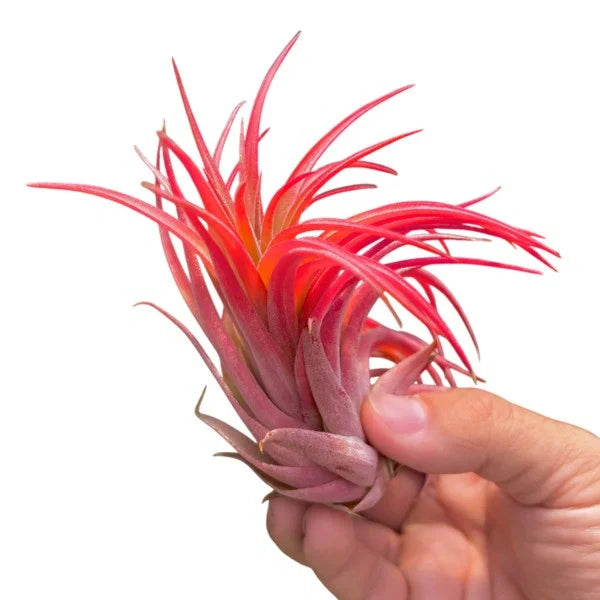
Tillandsia Ionantha Maroon - Air Plant
Size: Single Plant Without flower
Tillandsia ionantha 'Maroon' is a beautiful air plant known for its vibrant red to maroon coloration, especially when blushing before bloom. As an air plant (epiphyte), it doesn't need soil and thrives with proper light, water, and air circulation.
Here's a detailed care guide of Tillandsia Ionantha Maroon:
1. Light:
Bright, indirect light is ideal. A spot near a window that receives filtered sunlight (e.g., north or east-facing window) is perfect.
Avoid direct, harsh afternoon sun, which can scorch the leaves and cause them to fade or crisp.
Morning or late afternoon direct sun can be beneficial and intensify the red/maroon coloration.
If natural light is insufficient, use full-spectrum fluorescent or LED grow lights for 6-12 hours daily, positioned 6-36 inches away.
Rotate the plant periodically to ensure all sides receive adequate light and promote even growth.
Signs of insufficient light: Elongated or leggy growth, dull or fading leaf color.
2. Watering:
Tillandsias need to be thoroughly watered, despite being called "air plants."
Soaking is the preferred method: Submerge your Tillandsia ionantha 'Maroon' in room-temperature, low-mineral water (rainwater or distilled water is best) for 20-30 minutes, 1-2 times per week. In drier, hotter climates, you might need to soak more frequently or for up to an hour every 2-3 weeks.
Misting: Between soakings, you can mist the plant 2-3 times a week, especially in dry environments. Ensure the plant feels thoroughly wet but not dripping.
Crucial for drying: After watering, shake off any excess water from the plant, especially from the base and crevices, and allow it to dry completely within 2-4 hours. Placing it upside down can help prevent water from pooling and causing rot.
Signs of dehydration: Leaves feeling soft, lighter in color, or appearing wrinkled/rolled.
Avoid getting the flower wet if the plant is blooming.
Never plant in soil.
3. Air Circulation:
Good air circulation is vital to prevent fungal diseases and rot.
Ensure your Tillandsia ionantha 'Maroon' is placed in an open area where air can circulate freely around it.
Avoid enclosed containers or terrariums that limit airflow, especially if they stay humid for long periods. If using a terrarium, ensure it's open and the plant dries completely before being placed back inside.
4. Temperature:
Thrives in average to warm temperatures, ideally between 50-90°F (10-32°C).
Avoid temperatures below 50°F (10°C), as frost can be detrimental.
Can be kept outdoors in USDA hardiness zones 9-11 or during warm summer months, but ensure it's protected from extreme sun and cold.
5. Humidity:
Tillandsia ionantha generally appreciates moderate to high humidity (around 50-70% or above).
If your indoor air is dry, consider increasing humidity with a humidity tray, a cool-mist humidifier, or more frequent misting.
Signs of low humidity: Brown leaf tips.
Too much humidity combined with poor air circulation can lead to rot, so balance is key.
6. Fertilizing:
Fertilizing is not essential for survival but can promote growth and blooming.
Use a bromeliad or orchid fertilizer diluted to 1/4 strength once a month during spring and summer (the growing season).
You can add the diluted fertilizer to the water you use for soaking or misting.
7. Mounting and Display:
Do not plant in soil.
Mount your air plant on materials like wood, cork, or shells. You can use non-water-soluble glue to secure it.
Ensure the display allows for good air circulation around the plant.
8. Blooming and Pups (Propagation):
Tillandsia ionantha 'Maroon' typically blooms once in its lifetime, producing beautiful purple or yellow flowers (often with red bracts, which are specialized leaves that color up vividly).
The plant will "blush" with its vibrant red/maroon coloration before blooming.
After blooming, the parent plant will gradually decline and begin to produce offsets or "pups" around its base.
Propagation: You can separate these pups when they are about 1/3 to 1/2 the size of the parent plant. Gently pull them off, ensuring any small roots remain intact. The newly separated pups will continue to grow and eventually produce their own pups.
You can also let the pups grow into a clump around the mother plant for a fuller display.
9. Pests and Diseases:
Air plants are generally hardy.
Root rot: The most common issue, caused by excessive moisture retention. If the base or leaves become soft, mushy, or discolored (brown/black), it's a sign of rot. To prevent, ensure proper drying after watering and good air circulation. If rot occurs, cut away affected parts if possible.
Fungal infections: Can occur with poor air circulation or if the plant remains wet for too long.
Mealybugs and scale: These can appear as white, cottony masses or small brown/black spots. Treat by dabbing with a cotton swab dipped in rubbing alcohol.
By following these care guidelines, your Tillandsia ionantha 'Maroon' should thrive and display its stunning colors.

